For today’s post, I’m excited to share an interview with Blu and Roadspike, two long-time members of the MU* community who have run several of their own games and have played or assisted with many more.
While Blu and Roadspike have overlapping interests in roleplaying games, they bring complementary skills and strengths to the table. For example, Blu excels at website design and using visuals to enhance immersion, whereas Roadspike is good at balancing game systems and stats to support roleplay.
If I had to choose one takeaway from this interview, it’d be this:
Two heads are better than one! If you plan to run a game, bring a partner or trusted friends who can share your vision and help bounce ideas.
It’s even better if they have a passion for the aspects of game running and design that don’t excite you as much, as this will leave you with more time to focus on the parts of game running that you enjoy more.
Meet Blu and Roadspike, partners

Blu is a middle school teacher who enjoys teaching and being a mom. Outside of roleplaying games, she likes to do crafty activities like watercolor and crochet.
She started playing text-based RPGs in the days of AOL and found her way into MUSHes (Star Wars: Age of Alliances, then World of Darkness-themed games) through a friend.
“I honestly have stayed because of the amazing friendships I have developed over the decades I’ve been in this hobby,” said Blu. “Even when I take breaks, they always bring me back in. That community thing is a huge driving force behind my joy in this hobby.”
Roadspike runs a family-owned, one-screen movie theater with his father. His hobbies include practicing Historical European Martial Arts and playing computer games.
He started playing MUDs back in high school in the early ’90s. After spending many years on A Moment in Tyme (a Wheel of Time-themed game), he eventually got pulled into his first MUSH (Cuendillar, also WoT-themed) by friends.
“Not having to worry about the grind and just being able to focus on RP was fantastic, and I’ve stayed in the MUSH world ever since,” said Roadspike. “Just like Blu, it’s the people who keep me going, but I also just love the ability to tell a collaborative story.”
Together, they live on Whidbey Island in Washinton State with their daughter, affectionately nicknamed “Nebula” by a player in one of their former MUSHes.
Past games
I asked Blu and Roadspike to talk a little bit about some of their past games, since they’ve run several over the years.
For both of them, The 100 and The Savage Skies stood out as two of their more successful projects.

“We learned a lot from running The 100, but most importantly, we met a lot of great people there—Clockwork, Puzzlebox, Faraday, Domino, just to name a few. Those people have stayed in our circle of friends, and Faraday’s friendship launched us into being some of the first people to beta-test AresMUSH for her [with The Eighth Sea].”
The Savage Skies (TSS) no longer has a portal available to share, but it had a fun theme that both Blu and Roadspike enjoyed creating together.
“TSS had an original theme based around 1940s Dieselpunk with magic and dragons thrown in there,” said Blu. “We had so much fun running the game and building the theme. It also was the first game where I really got deep into unlocking the magic of CSS.”
Roadspike recalled, “For TSS, I was messing around with an Ares Droplet, using FS3 (Faraday’s Simple Skill System) to play out my Crimson Skies dreams, and Blu showed absolutely no interest in the idea – until we blended my beloved dieselpunk with modern magic, which is one of her favorite genres.”
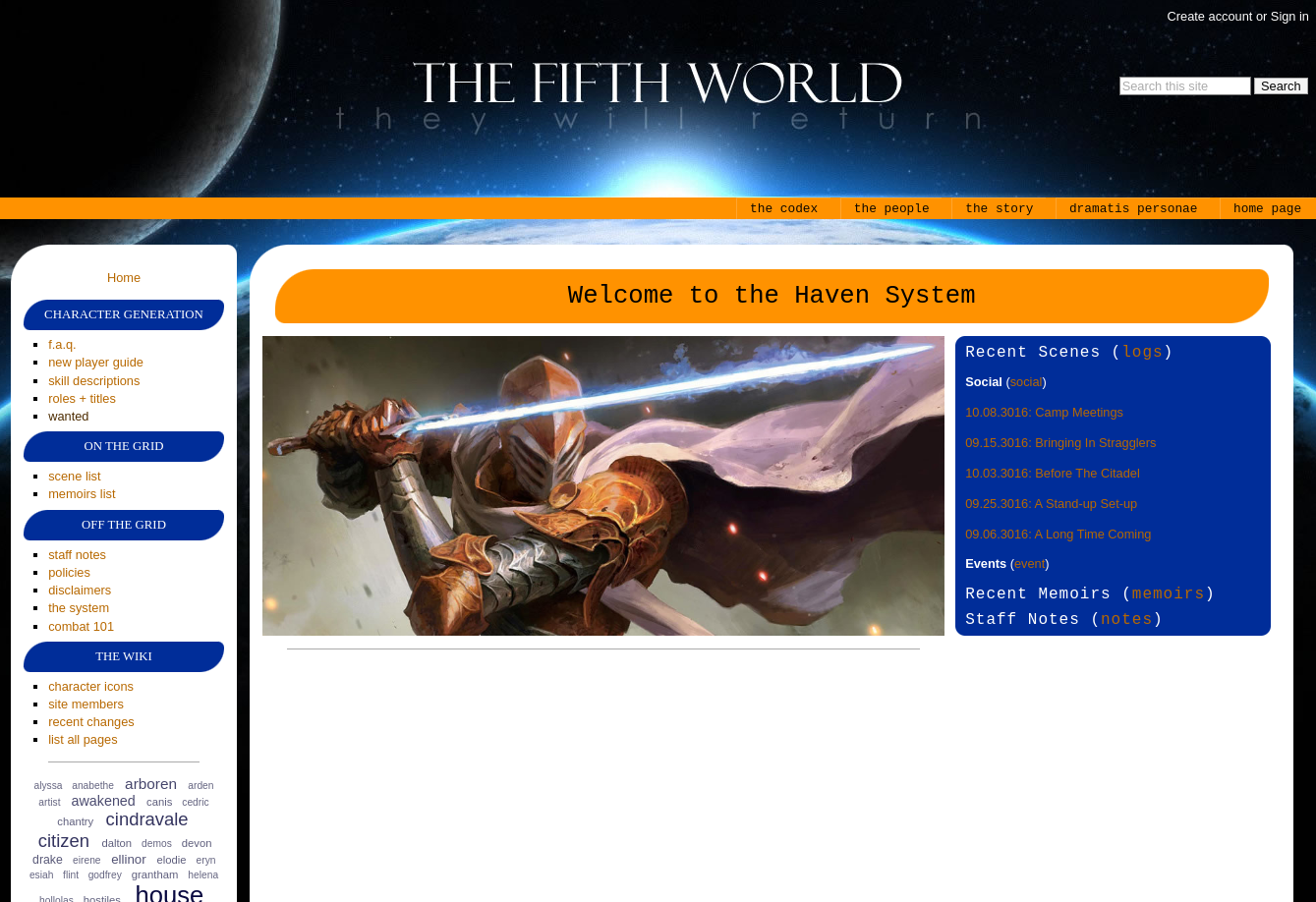
One of the reasons Roadspike enjoyed working on TSS’s theme is that it integrated real-world history but with some modifications to make it healthier for players.
“It was a real-world history that we’d worked hard to rationalize removing some of the more triggering elements without losing the stakes – or excusing the real horrors caused by humans,” he said.
“I believe our policy read, ‘Do not play out your hate fantasies here,’” added Blu.
“It was also a delicious opportunity to balance magic and machines, personal-scale and vehicle-scale combat, dragons and dirigibles,” said Roadspike. “There were a lot of levers to pull, and I think we found a pretty sweet spot with the balance.”
Current projects
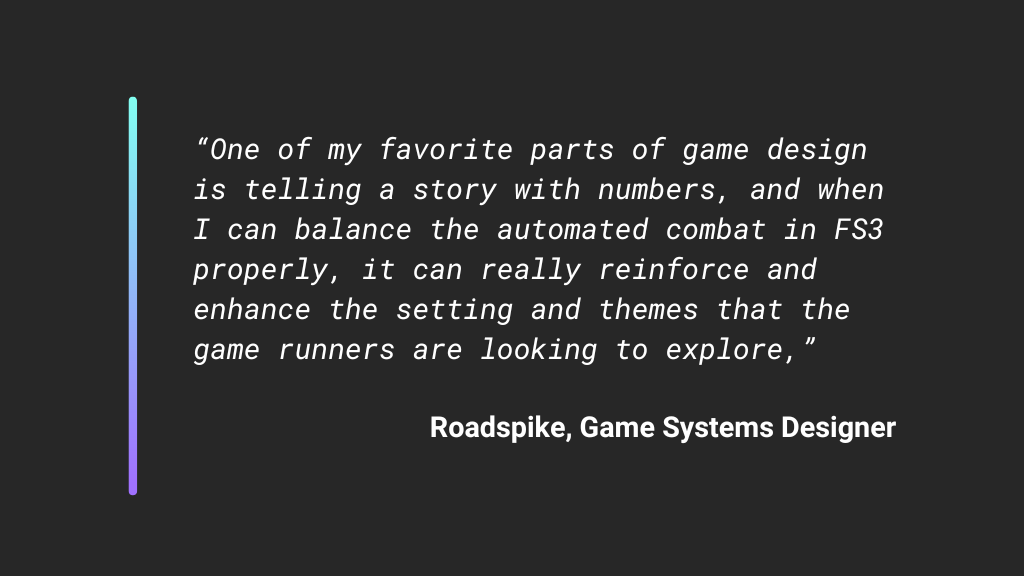
If you read the interview about Excelsior, then you already know Blu currently serves as CSS Designer and Server Admin for that game. But she also does some light CSS design for other games, such as The Sixth Estate.
“I really love working with games on creating a feel/look that resonates with the type of game they are running,” she said. “Aesthetics can really help immersion with a game and also support the mission behind the game.”
Since she isn’t wholly dedicated to running her own game right now, Blu is instead working on some CSS packages that she’d like to make available on AresCentral for game runners who don’t have CSS experience or a dedicated CSS designer on hand.
As for Roadspike, he does some light storytelling on various games, but an interesting thing about his hobby work is that he’s become known as someone who can help balance FS3 for just about any theme or setting.
“One of my favorite parts of game design is telling a story with numbers, and when I can balance the automated combat in FS3 properly, it can really reinforce and enhance the setting and themes that the game runners are looking to explore,” he said. “It’s a very fun challenge for me, and I’ve worked with everything from straight-up sword and sorcery to dieselpunk meets magic to Star Wars to modern day to post-apocalyptic to soap opera ‘social combat.'”
In fact, one of Roadspike’s dreams is to implement a full social combat system capable of representing the tangled web of social intrigue often found in historical settings.
“The difficulty with a social combat system is that it’s hugely more complicated than physical combat. Different people will react to different approaches and words very, very differently, while human bodies tend to react pretty much the same way when a metal stick is vigorously applied to them,” he said.
It’s not easy to build a system around social actions and still respect player agency, but for Roadspike, the process of getting it right is what makes it so much fun.
Inspiration and motivation to run MUSH games
When it comes to inspiration, Blu and Roadspike admitted that all of their games have come out of discussions about blending interesting settings and how to make them work for a MUSH-style game.
“The very first thing that we create is a mission statement, a description of what the game is intended to be, both ICly and OOCly, that we can refer back to throughout the process to keep us on the right track,” said Roadspike. “After that, we look at what we want the world to feel like, and then go into how we want the skill system and the web portal to support that. We’re always looking at what we want to play in the world that we’re creating, and at least for me, it’s the idea of playing in the world with other people that keeps me motivated.”
Blu agreed.
“We make games we want to play in, and that is really important to us,” she said. “We think about not just the setting, but the stories we want to tell, too. It’s really easy to make a game with a cool setting, but forget about the RP hooks that keep people playing in that setting, or forget what you’re going to do to keep the stories everyone is telling threaded together.”
No game lasts forever
Something else Blu said that really stood out to me is that she and Roadspike don’t go into the process thinking they’ll make a game that will last forever.
Rather, they focus on building a game that will last as long as the overarching storyline can support it.
This is a very different approach than you often see in games that have a lot more coded structure, like RP MUDs, where the implicit goal is to build out a game (the rooms, objects, mobs, systems, and mechanics) that can support an endlessly evolving meta-story or an endless number of plots.
One of the drawbacks of an “endless” RP game is that it eventually creates a group of entrenched veteran players who control the knowledge, power, and resources, and who will work to maintain that status quo. New players will have a hard time getting into the game, and without new players, the game will suffer from a lack of fresh stories.
This is what’s known as a stagnant game environment.
Instead of building games that will outlive their stories, Blu and Roadspike focus on building games that exist for their stories.
Finding a balance
But even in a MUSH, the systems and mechanics do matter and can make or break the experience for players.
“I think that systems and stats can run the gamut from ‘totally unnecessary to enjoy’ to ‘enriching and supporting’ to ‘getting in the way of’ RP,” said Roadspike. “That’s why it’s so important to get them right, because if you get them wrong, at best people are just going to ignore them, and at worst, the systems are going to add a barrier to play.”
So when Roadspike designs systems, he constantly refers back to the game’s mission statement.
“For example, if the game is intended to be a mixture of radio serials and modern magic, I want PCs to be hard to hurt so that they’re encouraged to do crazy things. But if the game is a post-apocalyptic survival game focused on how dangerous life has gotten, I want PCs to get hurt a whole lot more and think carefully about all of their actions.”
If you swapped the systems between those two games, says Roadspike, you’d end up with risks and consequences that don’t encourage the kind of theme or gameplay you want to support.
In the first case, players would be hesitant to do daring, heroic things because the consequences of failure would be too great. And in the second, players would leap into masses of enemies without a care in the world.
In either case, you’d have an imbalance that ruins immersion, and that’s not what you want.
“With a little practice, you can use the pure numbers of weapon stats, damage rules, and everything else in the system to help tell a story, to present a unified setting with consistent themes, and when you can do that, it’s a beautiful thing,” he said.
Lessons learned from running MUSHes
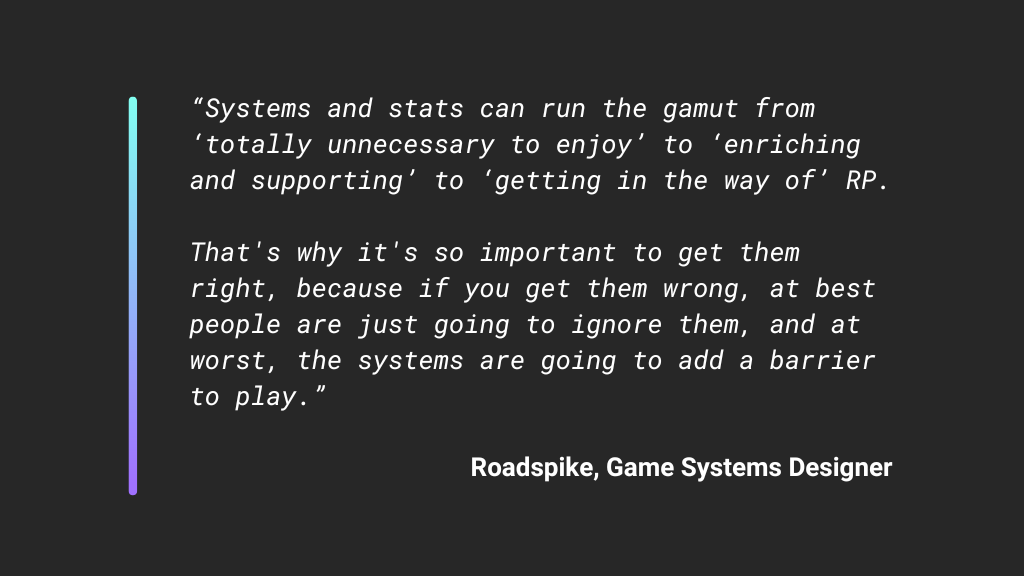
I asked Blu and Roadspike to share a few more lessons from their time as game runners.
For Blu, one important lesson was learning to embrace the tradeoffs of being a story admin and to enjoy her role as a storyteller.
“As game admins, we know pretty much everything, which does take some of that ‘excitement of discovery’ out of the stories, but I take a lot of joy out of telling those stories for others,” she said. “For example, on The Savage Skies, I accepted that my character was never going to meet and have dealings with the various Great Dragons; I instead took some serious enjoyment out of playing the Dragons for other people.”
For Roadspike, the biggest lesson was that you should design your game in a way that enables, if not encourages, the kind of RP you want to see.
“We wanted an interplanetary game on The Fifth World to emphasize the ‘in space’ part of ‘knights in space,’ but we didn’t want barriers to people being able to RP together, so we invented a system of portals that allowed instantaneous travel between them,” he said. “This also had the benefit of giving us a series of targets for the NPC enemies to go after. If we had instead opted for a travel system, for instance, it would have made it easy for people to say ‘my character wouldn’t make the effort to be there’ when they’re invited to RP. We want to design the setting to remove as many of those barriers as possible.”
In addition, Roadspike echoed Blu’s sentiments about staffing:
“I tend to be a proactive player, getting involved in a lot of stuff, but I learned back on The 100 that in order to avoid the appearance of bias, staff PCs have to hang back, stay pretty far out of the spotlight. Just one of the downsides of staffing,” he said.
Avoiding the appearance of bias
It should be noted that Blu and Roadspike are transparent about which PCs belong to them on the games they run, and I find that to be an interesting approach compared to the norm on RP MUDs.
On RP MUDs, especially those with character vs. character (CvC) conflict, admins will often hide their characters’ identities from players to prevent things like IC/OOC crossover and bias. They want to be able to play their games without being treated differently in character just because they’re staff, for example.
The problem with this approach is that in the absence of transparency, players will instead make guesses and assumptions about staff PCs based on things like personality or writing style.
Then, when these players see a presumed staff alt getting along with some other PC, they’ll interpret it as favoritism. Or when a presumed staff alt gets into conflict with another PC, it’s seen as targeted or as an abuse of game knowledge/power.
But these complaints won’t be out in the open where they can be addressed. They’ll occur quietly in private DMs among friends, where they’ll erode a game’s integrity and reputation one conversation at a time, regardless of the truth.
Thus, a policy that might seem well-intended on the surface can actually undermine the health of a game’s community due to a lack of transparency and trust, especially in games where the stakes are high and conflict is common.
This is why I generally advocate for transparency, even if it comes with its own set of drawbacks, such as having to take a backseat in RP like Blu and Roadspike mentioned.
If this topic interests you, I recommend reading this post next: How game design drives investment, stakes, and conflict in roleplay-intensive (RPI) MUDS.
Recommended resources and advice for running games
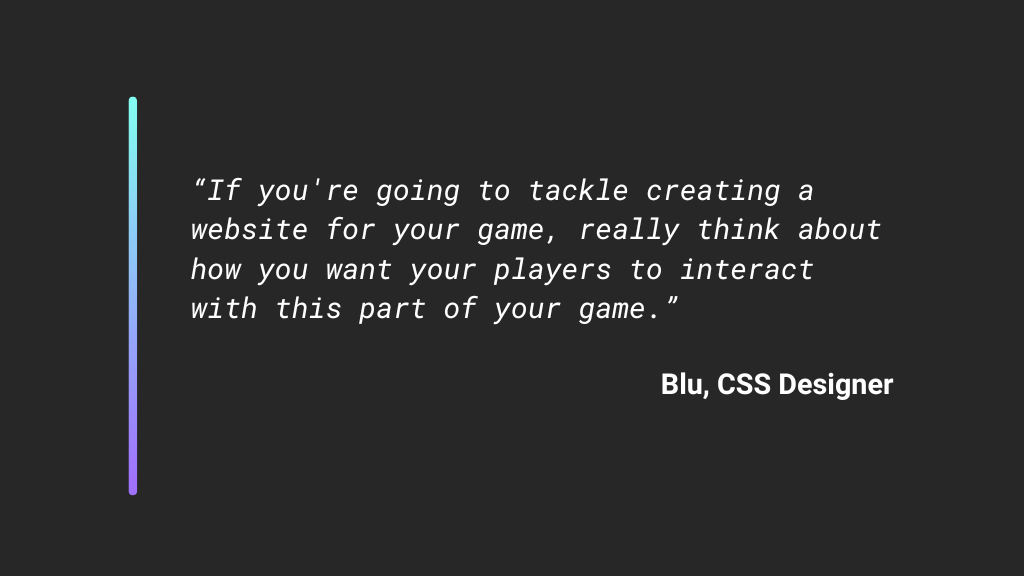
Lastly, I asked Blu and Roadspike for recommendations and advice for readers who might be thinking of running their own games.
Treat your game’s website like an extension of your game
As an expert in CSS, it’s no surprise that Blu’s first bit of advice had to do with web design.
“If you’re going to tackle creating a website for your game, really think about how you want your players to interact with this part of your game—and that’s important, too! Thinking of the website as a component of your game,” she said.
“When I approach designing a website for a game, I ask what they want it to feel like. Tat loved the notebook aesthetic I had on our Empty Night game; she wanted something similar to that for Shattered. So, that became what I built the game’s look around: notebooks, typewriters, scrawling fonts, notecards.
For Excelsior, there was a want for that clean comic book panel feel, and I took the Marvel colors into account when I designed it.
If you treat your game’s website like an extension of your theme, you’ll find that it helps with that immersion. Don’t be scared to look things up, too! There’s so many great CSS creators and contributors out there who have stuff that is open source. Nothing has to be built totally from scratch.”
This is great advice, and I’ll briefly take it a step further: your game’s website is also important for attracting new players and can help or hinder player retention. So make sure it’s easy for unfamiliar players to find the information they need to get into, and continue playing, your game.
Have a mission statement
Blu also circled back to something Roadspike mentioned earlier in the interview: having a mission statement.
“Two or three short paragraphs about what your game is meant to be about, provide, and support can really help guide staff and players when making game decisions,” she said. “Also, I’d HIGHLY recommend every game come up with a Social Contract that helps guide the game’s IC morality.”
As an example, here’s the social contract she and Roadspike used on their Empty Night project:
We want Empty Night to feel like a real community, and for everyone to be comfortable. But we also want to be able to RP about evil creatures, characters, actions, and themes, as appropriate for urban fantasy. With that in mind, we’ve created a social contact listing evils that players may encounter or participate in during the course of RP and what is acceptable OOCly.
Tier 1: Evil inherent to the setting which our characters may engage with, but never question or interrogate each other about.
- Killing non-humans.
- Killing non-humans with magic.
- Killing human goons in self-defense or the heat of combat without magic.
Tier 2: Evil which our characters may engage with, but which may be a point of conflict between characters.
- Making deals with Faeries.
- Type-ism (Wizards looking down on Practitioners, Faeries looking down on Changelings, etc).
- Committing crimes including theft, kidnapping, fraud, manslaughter, and murder.
- Making deals with demons (including becoming a hexenwolf for a scene).
- Killing humans outside of self-defense or the heat of combat.
- Killing people with magic.
- Non-human blood sacrifice to empower rituals.
Tier 3: Evil which may happen, but the player characters won’t engage in it, and will oppose it if it shows up.
- Vampires draining humans of blood/life-energy.
- Vampires addicting their herd to being drained.
- Racism, sexism, homophobia, etc (players may inflict this on their own PCs, but no one else’s).
- Warlocks creating cults to empower themselves.
- Taking up a Blackened Denarius.
- Selling your soul to a demon.
- Becoming a hexenwolf for more than a scene.
- Necromancy (controlling ghosts or zombies).
- Unwanted uses of psychomancy.
- Human sacrifice to empower rituals.
- Physical or psychological torture.
Tier 4: Evil which even villains won’t think to engage in on-screen, ever (nor will they be discussed on-screen).
- Hate crimes due to RL circumstances (racism, sexism, homophobia = no, Type-ism = okay (i.e. hate against werewolves))
- Sexual assault
- Using psychomancy for sexual purposes.
If you have suggestions on items to add to one of the Tiers, please let Staff know.
Blu and Roadspike created this social contract after being inspired by a blog post called “Best Practices For Historical Gaming,” written by James Mendez Hodes.
I read the post while writing up this one, and I highly recommend it to anyone thinking about running their own roleplaying game. Not just historical RP games, but any kind of RP game that borrows from real-world conflict or societal issues.
What’s next for Blu and Roadspike
While they’d love to run another game of their own someday, for now, Blu and Roadspike only have time to help out with other projects or participate here and there in other games.
“We just finished playing on The Network, and haven’t really found our next game yet,” said Blu.
“It’s really hard for us to run a game given our RL schedules, so right now I’m just consulting with games looking to use FS3 in interesting ways,” said Roadspike.
Still, they wouldn’t have had so many great experiences, or built so many friendships, if not for the community.
“Forever thankful to Faraday! She’s an amazing friend and has helped us immensely in our time in the MUSH world,” said Blu. “I’m also thankful to Tat from Spirit Lake, as her game brought me back to many friends I hadn’t seen in a while, and I also met a lot of new people from her game. I am also very thankful to Avarice, who dragged me over to Star Wars: Knights of the Old Republic MUSH because that’s where I met Roadspike (so sappy, I know). Huge shoutout to Ren as someone who has helped me when I am beating my head against the CSS wall!”
Roadspike echoed the props for Faraday, whose platform makes it easier for adults with busy lives to keep playing MU*s.
“Beyond the technical achievements, she’s been a good friend and wonderful collaborator on RP, and goes way above and beyond the call of duty helping people (myself included) learn Ares and FS3 better,” he said. “Way Back When shoutout to Matylena from A Moment in Tyme, who helped me improve as a roleplayer and helped me get involved in MUSHes. And thanks to Clockwork for letting me play with FS3 so much across the various seasons and mini-series of The Network, and for (almost) always saying, ‘Sounds fun, go for it,’ when I came up with a crazy idea on how to make something work.”
Thanks so much to Blu and Roadspike for taking time out of their busy lives to share their experiences as game runners! I wish them all the best IRL and with whatever game they end up creating in the future when they have more free time.
If you’re thinking about running your own game and could use some advice about website or systems design, you’ll find Blu and Roadspike (and other helpful members of the AresMUSH community) in the Ares Discord server.


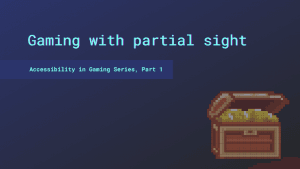
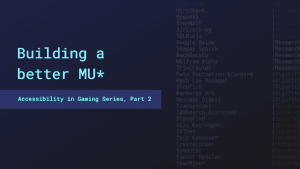
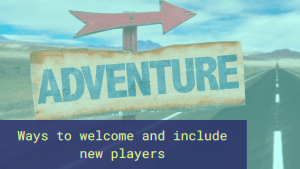

Leave a Comment